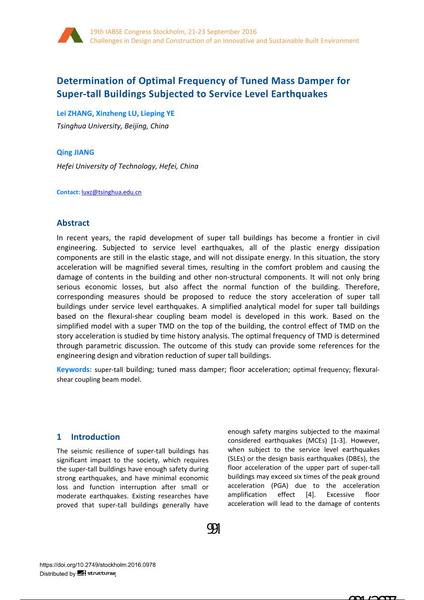Determination of Optimal Frequency of Tuned Mass Damper for Super-tall Buildings Subjected to Service Level Earthquakes

|
|
|||||||||||
Bibliografische Angaben
| Autor(en): |
Lei Zhang
(Tsinghua University, Beijing, China)
Xinzheng Lu (Tsinghua University, Beijing, China) Qing Jiang (Hefei University of Technology, Hefei, China) Lieping Ye (Tsinghua University, Beijing, China) |
||||
|---|---|---|---|---|---|
| Medium: | Tagungsbeitrag | ||||
| Sprache(n): | Englisch | ||||
| Tagung: | IABSE Congress: Challenges in Design and Construction of an Innovative and Sustainable Built Environment, Stockholm, Sweden, 21-23 September 2016 | ||||
| Veröffentlicht in: | IABSE Congress Stockholm, 2016 | ||||
|
|||||
| Seite(n): | 991-998 | ||||
| Anzahl der Seiten (im PDF): | 8 | ||||
| Jahr: | 2016 | ||||
| DOI: | 10.2749/stockholm.2016.0978 | ||||
| Abstrakt: |
In recent years, the rapid development of super tall buildings has become a frontier in civil engineering. Subjected to service level earthquakes, all of the plastic energy dissipation components are still in the elastic stage, and will not dissipate energy. In this situation, the story acceleration will be magnified several times, resulting in the comfort problem and causing the damage of contents in the building and other non-structural components. It will not only bring serious economic losses, but also affect the normal function of the building. Therefore, corresponding measures should be proposed to reduce the story acceleration of super tall buildings under service level earthquakes. A simplified analytical model for super tall buildings based on the flexural-shear coupling beam model is developed in this work. Based on the simplified model with a super TMD on the top of the building, the control effect of TMD on the story acceleration is studied by time history analysis. The optimal frequency of TMD is determined through parametric discussion. The outcome of this study can provide some references for the engineering design and vibration reduction of super tall buildings. |
||||
